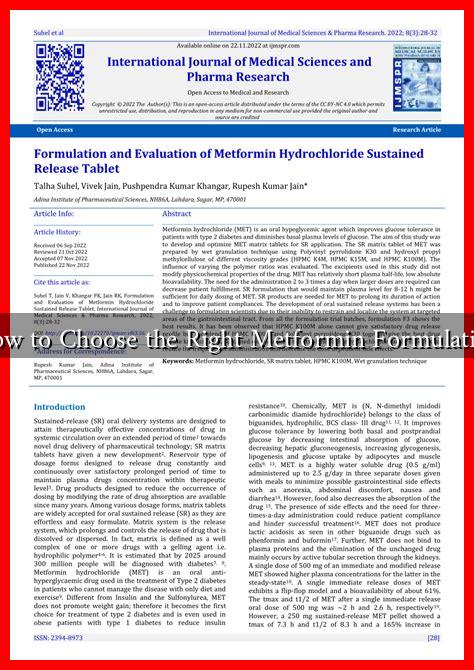-
Table of Contents
How to Choose the Right Metformin Formulation
Metformin is a widely prescribed medication for managing type 2 diabetes. It helps control blood sugar levels and is often the first-line treatment for this condition. However, with various formulations available, choosing the right one can be challenging. This article will guide you through the different types of metformin formulations, their benefits, and how to select the best option for your needs.
Understanding Metformin Formulations
Metformin is available in several formulations, each designed to meet different patient needs. The primary types include:
- Immediate-Release Metformin: This formulation is absorbed quickly and typically taken two to three times a day. It is effective for rapid blood sugar control.
- Extended-Release Metformin: This version is designed to release the medication slowly over time, allowing for once-daily dosing. It can help improve adherence to the treatment regimen.
- Liquid Metformin: Available for those who have difficulty swallowing pills, this formulation can be easier to take for some patients.
Factors to Consider When Choosing a Formulation
When selecting the right metformin formulation, several factors should be taken into account:
- Dosage Frequency: Immediate-release metformin requires multiple doses throughout the day, which may be inconvenient for some patients. Extended-release formulations allow for once-daily dosing, which can improve adherence.
- Side Effects: Metformin can cause gastrointestinal side effects such as nausea and diarrhea. Extended-release formulations may be better tolerated due to their gradual absorption.
- Patient Preference: Some patients may prefer liquid formulations over pills, especially if they have difficulty swallowing.
- Cost and Insurance Coverage: The cost of different formulations can vary significantly. Check with your insurance provider to see which options are covered.
Case Studies: Real-World Applications
To illustrate the importance of choosing the right formulation, consider the following case studies:
Case Study 1: A 55-year-old woman with type 2 diabetes was prescribed immediate-release metformin. She struggled with taking multiple doses daily and experienced gastrointestinal discomfort. After discussing her concerns with her healthcare provider, she switched to extended-release metformin, which improved her adherence and reduced side effects.
Case Study 2: A 45-year-old man preferred a liquid formulation due to his difficulty swallowing pills. His healthcare provider prescribed liquid metformin, which allowed him to manage his diabetes effectively without the discomfort of pills.
Statistics on Metformin Use
According to the American Diabetes Association, metformin is the most commonly prescribed medication for type 2 diabetes, with over 120 million prescriptions filled annually in the United States alone. Studies have shown that metformin can reduce the risk of diabetes-related complications by up to 30% when used appropriately.
Consulting with Healthcare Professionals
Choosing the right metformin formulation should involve a discussion with your healthcare provider. They can help assess your individual needs, preferences, and any potential contraindications. It’s essential to communicate openly about your experiences with different formulations, as this feedback can guide your treatment plan.
Conclusion
Choosing the right metformin formulation is crucial for effective diabetes management. By understanding the different types available and considering factors such as dosage frequency, side effects, and personal preferences, patients can make informed decisions. Always consult with a healthcare professional to tailor the treatment to your specific needs. With the right formulation, managing diabetes can become a more manageable and less daunting task.
For more information on metformin and diabetes management, visit the American Diabetes Association.

